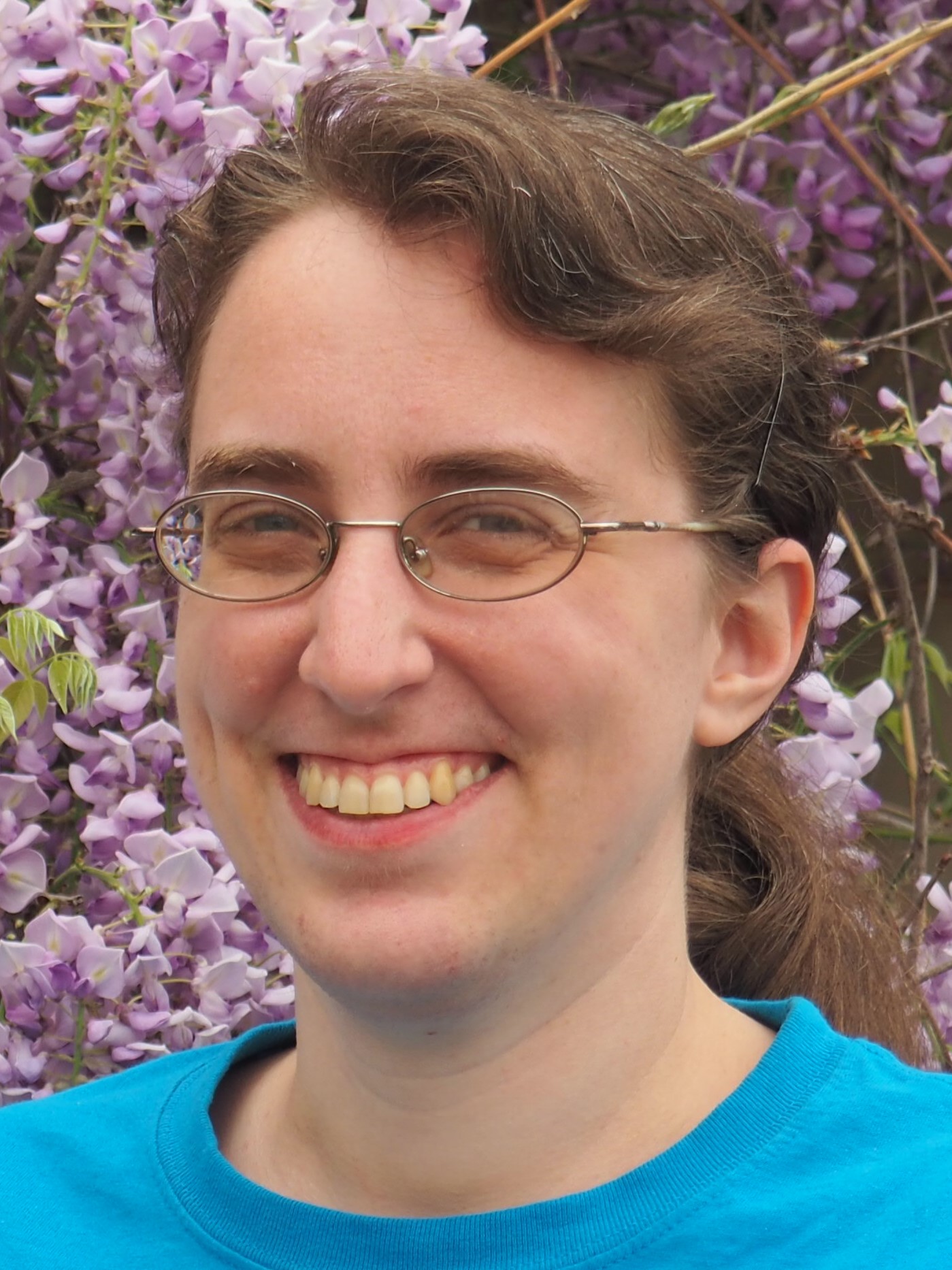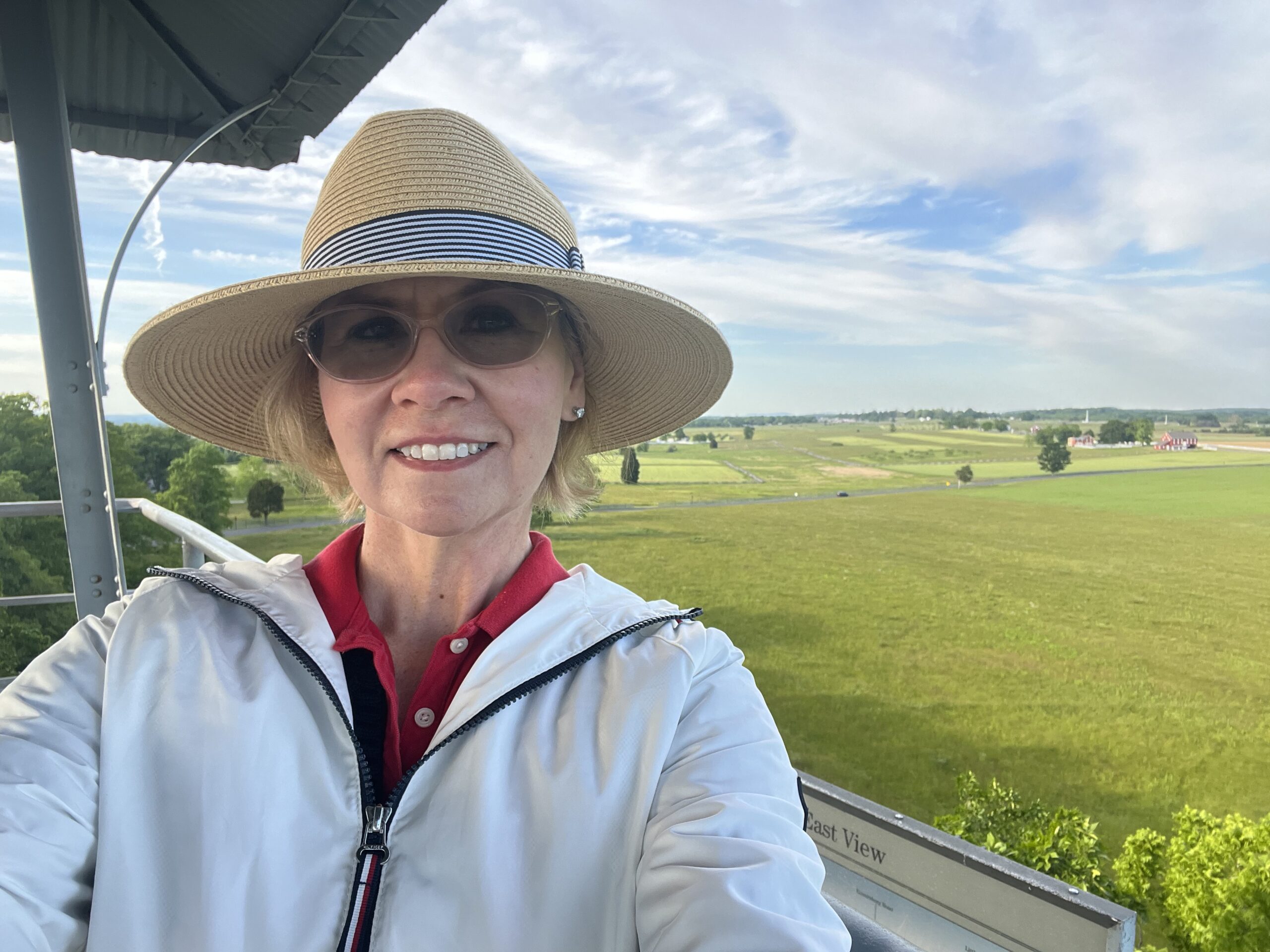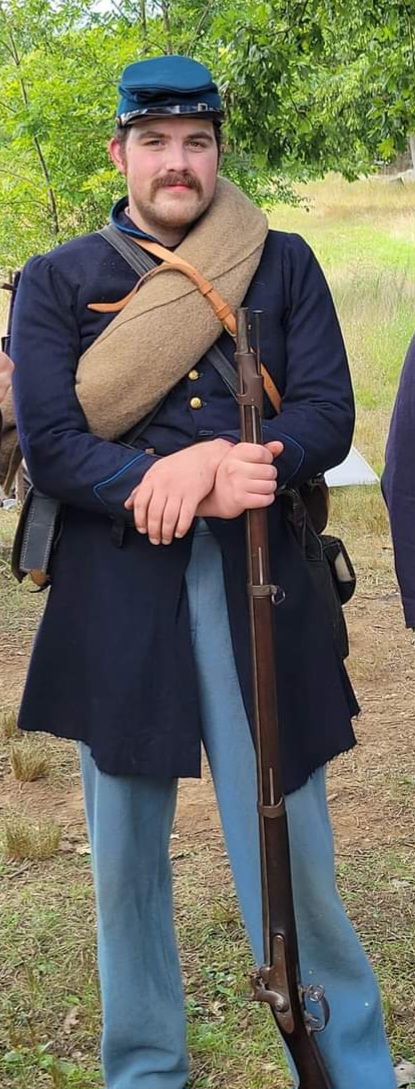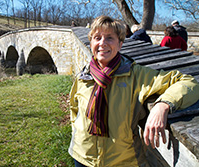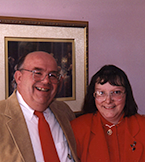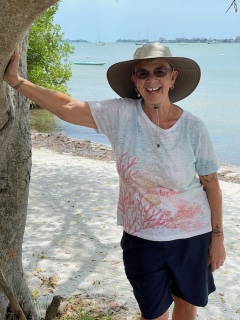Tell Your Story
Help us celebrate YOU: the amazing community of battlefield preservation enthusiasts who are saving hallowed ground, one acre at a time.
Read stories from supporters just like you!
Save us from ourselves so that future generations have a chance to walk on hollowed ground
I was first drawn to the study of military history by the Ken Burns series that premiered on PBS. I was very young at the time of it's initial airing but it was a family event. My mother was fascinated with the Civil War and passed on that fascination to me. It became...
Sam: Save us from ourselves so that future generations have a chance to walk on hollowed ground
I was first drawn to the study of military history by the Ken Burns series that premiered on PBS. I was very young at the time of it’s initial airing but it was a family event. My mother was fascinated with the Civil War and passed on that fascination to me. It became a bit of a passion and I’ve visited numerous battlefields, classes and guided tours about the Civil War throughout my life.
Preserving American history is important. Trying to maintain fragments of the landscape as they were, to capture that time in America’s history; will help our nation in understanding where we’ve come from, what we’ve achieved and how we’ve arrived at the places we find ourselves today. It’s myopic to build upon sacred ground where our forefathers bled and sacrificed so much. The buildings that seek to replace the battlefields will likely not last for a hundred years. They’ll be a stain on the landscape of what was lost as opposed to a solemn site that marks the great American struggle. It’s always saddening to hear about another developer or business seeking to build upon a battlefield but it’s a positive as well. That there are like minded people out there that wish to make a concerted effort to protect these lands. Help hold onto them for future generations so that they too may walk upon the grounds where battles were fought. Following the crests and dips of a natural landscape and try to feel for a moment what went through the minds of those that came before us. History can come alive and touch more people when there is readily available access to it. Future generations shouldn’t have to point at derelict structures and say that just past that husk of a building was where a battle was fought that helped shape the destiny of this country. It’s our shared history as a country and we should continue to try and preserve it to be shared.
Ramblings of a History Geek
My twin sister Ruth and I became interested in the Civil War when we were 11 years old. I read biographies on Gen. Robert E. Lee and Gen. U. S. Grant, and then, since I liked the two generals, I made them out of clay (we were always making things out of modeling...
Rebecca: Ramblings of a History Geek
My twin sister Ruth and I became interested in the Civil War when we were 11 years old. I read biographies on Gen. Robert E. Lee and Gen. U. S. Grant, and then, since I liked the two generals, I made them out of clay (we were always making things out of modeling clay). Because we have always had cats as pets and “catified” everything (even when playing Robin Hood outside as kids), my clay Lee and Grant came out as cats. We became interested in the Civil War and kept reading books…and kept making Civil War cats. A few years into it, we began making dioramas. Now, 29 years later, we own a museum in Gettysburg of the dioramas that we have made (Civil War Tails at the Homestead Diorama Museum).
Ruth and I were homeschooled, so Mom would buy books on all sorts of topics. Two of those books were the biographies that sparked our interest. Because we were homeschooled, we could let our interest blossom, and Mom and Dad were supportive in buying us 600+ Civil War books, taking us to reenactments, and taking us to battlefields.
I think the first time that the importance of battlefield preservation really struck me was in 1999, when our dad took us on a trip through the South to visit Civil War sites (the impetus being to visit Andersonville, where our great-great-grandfather’s brother died. Our dad is the third of five generations named after Pvt. Luke Brown [8th PA Cav’y]). One of the battlefields we visited was Fredericksburg. As I stood at the stone wall on Marye’s Heights, I gazed off across… backyards. Houses. Swing sets. I couldn’t see the river. I had no idea where the town would have been (roughly) during the battle. I had no reference points, and since I hadn’t read in-depth about Fredericksburg, I couldn’t visualize how far away the river and other features might be. It really struck me how fortunate we are to have Gettysburg preserved. Pickett’s Charge has always been my favorite part of my favorite battle, and when I visit the Angle, I can see exactly where the tree line and Confederate line were because…the trees are still there.
In college, I found the CWPT and joined it. Of course, with charities and non-profits, donors are always looking to see low overhead, maximum good done with each dollar, etc. CWPT has never disappointed. It is one of the few organizations that I’ve never had to wonder how much of each dollar is really going to preserving the land. Now, 20+ years later, I don’t donate as much as I would like (due to finances), but Ruth and I still try, because it is important work.
I’m glad to see ABT working to get students interested in history by visiting battlefields and engaging with the history. We hope to do the same with our museum, and with 9 years of operation under our belts, we are seeing kids who are now history buffs because they visited our museum. But I think one important aspect of our dioramas is that we can point out landmarks and locations that people saw or will see when they tour the battlefield. We can say, “That’s the Copse of Trees; it has a black iron fence around it now.” “Did you see the High Water Mark monument? It looks like a big book? It would be in that corner of the diorama.” “Do you remember the castle-like monument for the New York regiments? That’s here on the diorama.” And, since our scenes are to-scale and show a specific point in time, people can visualize the action, and then take it with them onto the field. Countless people have commented that after seeing our dioramas, now they can visualize what they learned about on the battlefield tour. So, the museum and battlefield can work together that way, and I think it helps people to make the connections and to have the information “click,” and all of that will make their visit more memorable.
On a personal note, I have really come to appreciate battlefield preservation for how it can impact our dioramas. We just completed our diorama of Little Round Top this year. It is 11 feet long and has 2,600 clay rocks based off of photos of the actual rocks. Now, for Devil’s Den, I think a reasonably accurate diorama could be made if one only had period photos to work off of. With Little Round Top, I had only a few period photos taken along the crest; the majority of the photos in the books I have were taken from Devil’s Den, across the valley. They are virtually useless for knowing the shape and location of rocks on the crest. So, it was extremely–I’ll even say, vitally–important for our work that we could go out onto the hill and take photos of the actual rocks. Combined with satellite views from Google Maps, and the period photos where possible, we could make 2,600 accurate rocks. It wouldn’t be possible without battlefield preservation. Granted, not everyone cares that their diorama have accurate rocks. But we do, since it’s possible.
On another personal note, I love being able to walk to the Angle (yes, I now live a mere 15-minute walk from my favorite spot on my favorite battlefield!!) and to think about all the stories that I’ve read for decades–and to walk where it happened! To see Garnett coming on Red Eye, to walk where Armistead and Cushing trod, to walk around the “rough ground” where Capt. Smith exclaimed, “Douthat, what are you doing?!?” So many individuals are so familiar to me, after years of reading about Pickett’s Charge. Maybe just a sentence or two about the man, but I know his name–and I can walk where the events happened. Or, I can take my black dog to Culp’s Hill and “say hi” to Gracie, the black Confederate dog who was mortally wounded as her regiment, the 1st Maryland (CSA) charged. And Pardee Field: “It is murder, but it’s the order.” So many snippets of dialogue or stories. Some are a bit hazy, barely remembered until I reread the books, but a name or a location brings them back. It’s just very cool for this history geek to be able to walk the ground.
Why are preservation and teaching history important? Well, there’s a reason for the saying, “History repeats itself.” So learning history can prompt one to step back and see through lies (for example, what aspects of today’s politics/culture seem awfully similar to the Roman emperor throwing bread to the masses and putting on games, while stealing the Senate’s power right out from under their noses?), or it can offer comfort (“this type of thing has happened before”; “someone always survives, even at Andersonville and Auschwitz”), or it can offer inspiration (Sgt. Tozier, 20th Maine, grew up with an abusive alcoholic father… and ended up earning the Medal of Honor on Little Round Top, just for doing his job and protecting the flag. How many kids today need to hear that? That your future does not have to be crippled by your upbringing?).
And yes, learning history also helps us to see mistakes that were made, how far we’ve come, how far we have to go. But I think the aspect that is often lost is the plain fact that people back then were human and made mistakes, just like we are human and make mistakes. I think people have a tendency to swing to one or the other extreme and forget the flip-side. Either the people in the past got it all right, or the people in the past got it all wrong-wrong-wrong and must be obliterated. But, properly, we need a balance. People in the past were muddling through life, doing the best they could, just as we are. And in 200 or 2,000 years, people will look back on us and think how backward and wrong we were. So, while learning history is important, it’s equally important to teach history as shades of gray, not cut-and-dried black-and-white.
So why is history important? To learn–as a nation, as a culture/society, as a person interacting with others, and as a person internally/morally. Where does battlefield preservation play into this? To make history come alive, to see history, to engage with it. Not everyone will “get it” when they tour a battlefield, but they have a better chance than by sitting in a classroom. And if their tour guide makes history come alive, then their chances are even better.
On a different aspect, preservation is important because it’s preserving the land where our nation was forged, whether in the Revolutionary War or the Civil War or 1812. Yes, Gettysburg is a field–it was in 1863, it is now, it’s not an important mountain pass or something. But men were fighting for what this country was built on. One only has to read Henry Kidd’s reminiscences (“Riding with Custer”) to see how these college kids had a real, full sense and awareness that they were fighting for what their grandfathers had created. These are 19-year-olds going to war, not merely to leave the house and see the world, or because they figured they should; they go because the torch has passed to them to preserve the most-carefully-constructed republic ever. And I wish that was the emphasis in Gettysburg, especially. I guess it’s not the “in” thing anymore to talk about how amazing our republic is, but we really do live in the best government in the world. (I’m talking about how it was designed, not necessarily what it’s become.) I heard once that the push to rewrite/erase history is not an effort to “get it right” but an effort to erase the United States. Lose the history, and you lose the nation’s identity. I think it’s very true. Unfortunately, I think the emphasis nowadays is on ghosts and paranormal. People want ghosts and ghost stories, not real stories of real people. But that just means we have our work cut out for us, doesn’t it?
Why is ABT important? Because you’re preserving history. One only has to look at the desperate fight by the SS United States Conservancy to save the last, greatest, fastest ocean liner of the United States, the SS United States. She was the top of the line in the 50’s. Her engines were classified for decades, their design was so advanced. She still holds the speed record for crossing the Atlantic. But no one is stepping up to give her a pier when she gets evicted from her current location. The pier owners don’t care, the city of Philadelphia doesn’t care. New York doesn’t seem to care. The Navy–which was involved in her construction–isn’t stepping up. A true icon, still sound and intact, able to be converted into business space, and a ship geek’s absolute dream–and she is facing the very real possibility of being scrapped or reefed (at least the latter will mean she still exists and is not completely gone) in a matter of weeks. Losing SS United States is no different than paving over Gettysburg. And I mean every single word of that. Build a Walmart in the shadow of El Capitan in Yosemite. Scrap Old Ironsides. For that matter, develop the beaches of Normandy, don’t bother repairing Notre Dame, and toss out the Mona Lisa. It’s just history and old stuff. What does it matter? Strange to say that, isn’t it? It goes against every fiber in our collective being. Without organizations like American Battlefield Trust or the SS United States Conservancy (who already saved the ship from scrapping once, in the early 2000’s), we lose every tangible piece of history. Do we need to save every patch of dirt where a cannon parked? I don’t know. But I’m sure glad that Lee’s Headquarters is finally preserved and safe. We like to think that no one would really mess with it, but…we’re about to let our nation’s last great ocean liner be lost forever, so…
ABT, like every preservation organization (wildlife, farmlands, wild horses), is fighting an uphill battle. I imagine it’s easy to see what is lost, what couldn’t be saved, but each preservation/rescue organization makes a difference to the what they do save. ABT not only makes a difference for the acre of land itself (and the history that occurred there), but also for the people who will visit that acre from now on. ABT is not just about preserving the dirt—it’s about making it meaningful, whether through interpretive signs and trails, or by bringing groups of people out to learn and experience. We often comment that with our museum, we want to get kids (and adults) interested in the history, but if they go home wanting to make dioramas, that’s okay, too. Anything that sparks creativity, interest, hands-on hobbies, learning…. Making people interested and curious is, I think, how we create learners. And learners will keep reading/listening, and they’ll come back, hopefully with friends. We can’t change the nation. But we can do our part, in our corner.
Keep up the good work.
It started with a miniseries…
I first became interested in the American Civil War when, in the 5th grade, my family watched a CBS miniseries called "The Blue and The Gray." I'm not sure what it was about the show, since it's not particularly accurate, that captured my attention, but I went on to...
Nancy: It started with a miniseries…
I first became interested in the American Civil War when, in the 5th grade, my family watched a CBS miniseries called “The Blue and The Gray.” I’m not sure what it was about the show, since it’s not particularly accurate, that captured my attention, but I went on to study the life of Clara Barton for a project in 6th grade, read John Jake’s “North and South” Trilogy, and then began reading non-fiction history books. However, it wasn’t until I was able to visit Gettysburg National Military Park in 2021 that I really began to understand the devastation that war caused. My partner and I returned to Gettysburg in 2023 and added Antietam to the trip. That led to more reading and a desire to revisit those sites and spend more time at each place of significance on the battlefields. I am so grateful for these opportunities to visit these sites because I can now imagine what Barksdale’s men saw as they fought across the Peach Orchard or what the Irish Brigade encountered when they approached Bloody Lane. The more I read, the more I understand how that war continues to impact American culture. I support the American Battlefield Trust because everyone should visit at least one of the battlefields pivotal in American history and study the people who lived and died there.
A Battlefield Journey
One of my earliest recollections is receiving books as presents from my parents, and my mom taking me to get my library card. I devoured all kinds of history books, but particularly the Civil War, WWII, the American Revolution, even the French & Indian War. By...
Joseph: A Battlefield Journey
One of my earliest recollections is receiving books as presents from my parents, and my mom taking me to get my library card. I devoured all kinds of history books, but particularly the Civil War, WWII, the American Revolution, even the French & Indian War. By third grade I was playing Avalon Hill board games. Family vacations often involved touring battlefields in Virginia and adjacent states. I am trying to visit some now that I am retired I am trying to visit some, although that is not exactly my wife’s cup of tea. But I did acquire a daughter-in-law who likes battlefields! I was able to visit Brandywine recently, and actually saw workmen restoring a parcel recently acquired by the trust. In all honesty, I see battlefield preservation as a way of conserving green areas before they disappear entirely.
Our Next generation Is our next generation of stewards.
My family has always brought me up to respect conservation efforts and preservation of historical grounds. From a young age I was very taken back with the history of hundreds of historical sites across Pennsylvania and the Mid Atlantic. Battlefield Preservation is...
Jared: Our Next generation Is our next generation of stewards.
My family has always brought me up to respect conservation efforts and preservation of historical grounds. From a young age I was very taken back with the history of hundreds of historical sites across Pennsylvania and the Mid Atlantic. Battlefield Preservation is needed for both memorial and educational opportunities. As we face growing urban and suburban sprawl and commercial expansion towards our historic sites everything from Governor Simon Snyder’s Mansion to Fort Duquesne to Gettysburg and Valley Forge Battlefield Preservation and education is important because of the fact that it shows the proud, challenging and deadly history our nation has been through. As a Living Historian I want to help spark increased interest and education of the history and backstory of our nation and her struggles and preserve land which holds the historical value of our young and complex history. I donate to the American Battlefield Trust because the resources and history they have at getting results is inspiring to continue the educational and preservation opportunities.
I hope that the American Battlefield Trust can continue for centuries through stewards who will fight like heck to ensure preservation is successful and I hope thousands acres more will be preserved and transformed to education millions.
Gettysburg – An American Inspiration
I was always intrigued as a young boy with Civil War history but never experienced the true inspiration until I first visited and began to study in much more detail, the circumstances surrounding the Gettysburg campaign. Thirty-some years later I have been fortunate...
Thomas J: Gettysburg – An American Inspiration
I was always intrigued as a young boy with Civil War history but never experienced the true inspiration until I first visited and began to study in much more detail, the circumstances surrounding the Gettysburg campaign. Thirty-some years later I have been fortunate enough to have lived for a dozen years near the battlefield, affording me the opportunity to be a frequent visitor. Moreover, this proximity to, and my frequent visits, afforded me to attend numerous learning opportunities such as roundtables, seminars and various tours, as well as a firsthand experience when reading and studying it more. Given my in-depth study of the Civil War, and more specifically, the Gettysburg campaign, coupled with a career in leadership positions, I have been able to use my knowledge to help train other executives in government positions to learn more about the highly contemporary leadership lessons to be learned from the various generals who were principals in this historic event. Given its everlasting value as both an important chapter in American history, as well as the lessons to be learned, it is critical that the American Battlefield Trust continue with its important work. Especially today, when so much of our history is being erased given its unpleasant nature, the Trust must preserve those places where we can still experience and learn from American history.
Feel the Souls
It would seem that from an early age, I have had an interest in history, specifically military history. My dad was a WWII vet although I didn't appreciate it as much as I should have growing up. I spent four years in the Army including a year in Vietnam. I feel that...
Anthony: Feel the Souls
It would seem that from an early age, I have had an interest in history, specifically military history. My dad was a WWII vet although I didn’t appreciate it as much as I should have growing up. I spent four years in the Army including a year in Vietnam. I feel that myself and all veterans have a special bond with other soldiers no matter what conflict in which they served. My first visit to a Civil War battlefield was to Gettysburg some fifty two years ago and most recently for the popup tour of Little Round Top in August 24.
Each time I’m there, I get a feeling that I can’t describe adequately except to say that I can “feel the souls”. It’s a feeling that cannot be experienced standing in a shopping center parking lot.
My wife and I chose to become Color Bearers because battlefields MUST be preserved and cherished so that legacy of those soldiers, and all those who at one time or another have put themselves in harm’s way will not be lost.
American Grit
A trip to Gettysburg opened our hearts. As soon as we drove past the split rail fences in the open grassy fields our spirits elevated in reverence to the battlefield. Gallantry, poignancy and loss of American lives on both sides brought to mind the strength of the...
Robert: American Grit
A trip to Gettysburg opened our hearts. As soon as we drove past the split rail fences in the open grassy fields our spirits elevated in reverence to the battlefield. Gallantry, poignancy and loss of American lives on both sides brought to mind the strength of the American spirit. It was the bloodiest of American wars because Americans were facing their toughest enemies ever!
Besides, there is plenty of acreage in America for another shopping mall.
Feel the Souls
It would seem that from an early age, I have had an interest in history, specifically military history. My dad was a WWII vet although I didn't appreciate it as much as I should have growing up. I spent four years in the Army including a year in Vietnam. I feel that...
Anthony: Feel the Souls
It would seem that from an early age, I have had an interest in history, specifically military history. My dad was a WWII vet although I didn’t appreciate it as much as I should have growing up. I spent four years in the Army including a year in Vietnam. I feel that myself and all veterans have a special bond with other soldiers no matter what conflict in which they served. My first visit to a Civil War battlefield was to Gettysburg some fifty two years ago and most recently for the popup tour of Little Round Top in August 24.
Each time I’m there, I get a feeling that I can’t describe adequately except to say that I can “feel the souls”. It’s a feeling that cannot be experienced standing in a shopping center parking lot.
My wife and I chose to become Color Bearers because battlefields MUST be preserved and cherished so that legacy of those soldiers, and all those who at one time or another have put themselves in harm’s way will not be lost.
Why I Have Decided To Leave A Legacy Of Preservation
One of the great privileges—and joys—of my life has been my affiliation with the Civil War Trust and, before that, with one of its predecessor organizations, the Association for the Preservation of Civil War Sites. As a human being, mother, grandmother, and citizen,...
Dr. Mary Abroe: Why I Have Decided To Leave A Legacy Of Preservation
One of the great privileges—and joys—of my life has been my affiliation with the Civil War Trust and, before that, with one of its predecessor organizations, the Association for the Preservation of Civil War Sites. As a human being, mother, grandmother, and citizen, there are few things more important to me than leaving this legacy of preservation behind when I am gone and providing for the work’s continuation.
I became interested in the Civil War, as did many other people, when I was young. I read a kids’ biography of Clara Barton when I was eleven or twelve; Clara came under fire during the battle of Antietam, and I still remember that book’s description of “the dark, quiet valley of Antietam Creek” on the night before the battle. As I look back, I know that’s when I was “hooked.” My fascination with that battle has endured and grown, as has my interest in the Civil War.
I became involved with the modern battlefield preservation movement in the late 1980s when, as a history teacher and graduate student, I saw the grave threat posed to Antietam by the possibility of commercial development at the historic Grove Farm, scene of the iconic Alexander Gardner photograph of Abraham Lincoln and Gen. George McClellan taken near Sharpsburg soon after the battle.
One of the great privileges—and joys—of my life has been my affiliation with the Civil War Trust (now a division of the American Battlefield Trust) and, before that, with one of its predecessor organizations, the Association for the Preservation of Civil War Sites. I was an early member of the APCWS, whose board I joined in the late 1990s.
As a human being, mother, grandmother, and citizen, there are few things more important to me than leaving this legacy of preservation behind when I am gone and providing for the work’s continuation.
Why We Want Battlefield Preservation To Be Our Legacy
We both became aware as we walked the battlefields that they were there for us because someone in the past thought that they should be given to the future for generations to enjoy, study and perhaps wonder at what occurred there. For us it is a unique feeling to leave...
Ken and Wanda Hayward: Why We Want Battlefield Preservation To Be Our Legacy
We both became aware as we walked the battlefields that they were there for us because someone in the past thought that they should be given to the future for generations to enjoy, study and perhaps wonder at what occurred there. For us it is a unique feeling to leave something to the future for people we will never know, but to realize now that they will experience what we have experienced.”
–Ken and Wanda Hayward
Jan Kovarik
Historical records—paintings, photographs, and books—are one-dimensional. History is three-dimensional. You need the place where that history happened in order to see, touch, and understand the history. Reading about the signing of the Declaration of Independence is...
Jan: Jan Kovarik
Historical records—paintings, photographs, and books—are one-dimensional. History is three-dimensional. You need the place where that history happened in order to see, touch, and understand the history. Reading about the signing of the Declaration of Independence is nothing compared to standing in that room, on the same floorboards, where those men stood. Reading about any battle during the Civil War is educational, but not as enlightening as standing on the ground where that battle happened. I found an extended life-long passion in being able to literally “touch” history—use on the same stone steps, touch the same doorknob, stand in the field, walk along a trench line, look out from a parapet. I re-ignite that passion every time I have the privilege of standing on a battlefield, or make a contribution to save one. We cannot relegate this country’s history to paintings, photographs, and books. We must preserve the “places”—forever—so that everyone has the opportunity to make the connections, “touch” history, and perhaps find their own passion.

